Climatic Vulnerability of El Mirador de Lambayeque Archaeological Complex (8th–11th Century AD): Morphometric Analyses of Digital Surface Models
Abstract
1. Introduction
2. The Lambayeque Region and El Mirador de Lambayeque Archaeological Complex
3. Materials and Methods
3.1. Orthophotogrammetric Survey and DSM
3.2. Morphometric Analysis and Parameters
- -
- Convergence Index (CI): a parameter based on the aspect allowing the recognition of convergent (channel/gully) and divergent (ridge) areas. The CI is calculated based on the exposure of adjacent raster cells and can reach values from −10 to 10 [45]. The CI is defined by the following equation:
- -
- A channel network was mapped following the algorithm of Wang and Liu [46].
- -
- Topographic Wetness Index (TWI). This parameter allows us to recognize the areas where the water flows and/or accumulates [47]. The TWI is a dimensionless parameter used in hydrology to determine the balance of the catchment water supply and local drainage, thus providing information on the possible runoff generation [48]. The calculation of the TWI requires the local upslope area to drain through a certain point per the unit contour length, A, and the local slope, S. This parameter is calculated with the following relationship: TWI = ln[(A)/tan(S)]. We evaluated the spatial distribution of the TWI by applying this formula to the DSM of EMLAC. The results are reported in Figure 4b.
- -
- Closed depressions (CD). This parameter identifies the areas where the water may stagnate, i.e., the areas surrounded by higher ground in all directions. We applied the algorithm by Wang and Liu [46], which was validated in the field by Pardo-Igúzquiza and Dowd [49]. We obtained a digital map of the depressions by the map algebra operation of subtracting the depression-free DSM from the original DSM. The results are shown in Figure 4c.
- -
- Total Catchment Area (TCA). The TCA identifies the zones where the water may form streams. The TCA measures the extent of the downslope surface flow pathway. We employed the algorithm proposed by Quinn et al. [50]. The equation defining the TCA is as follows:where a is the catchment area, l is the flow path length, and k is the curvature of the contour line, equal to the inverse of the radius of curvature. The results of the TCA at EMLAC are reported in Figure 4d.
- -
- Wind Effect Index (WEI). We determined the amount of upwind and downwind exposure in the DSM of EMLAC by calculating the WEI dimensionless parameter. Values of <1 indicate the areas shielded from the wind, whereas values of >1 identify the areas exposed to wind. To evaluate the exposure of EMLAC to the wind, we selected a wind direction of N165°, which represents the prevailing yearly direction along the northern coast of Peru, also during the ENSO events [42]. The WFI was determined following Boehner and Antonic [51]. The results are shown in Figure 5a.
- -
- Solar radiation (SR). We mapped SR on the DSM by applying the area-based model of Fu and Rich [52]. The SR values were obtained by integrating the aspect and shadow effects on DSMs. SR includes direct, diffuse, and reflected radiation. Direct radiation is the main component of the total irradiance, the diffuse radiation is the second component, and the reflected radiation is very small and may be neglected. The results are reported in Figure 5b.
4. Results
5. Discussion
6. Conclusions
Author Contributions
Funding
Data Availability Statement
Acknowledgments
Conflicts of Interest
References
- Kintigh, K.W.; Altschul, J.H.; Beaudry, M.C.; Drennan, R.D.; Kinzig, A.P.; Kohler, T.A. Grand challenges for archaeology. Proc. Natl. Acad. Sci. USA 2014, 111, 879–880. [Google Scholar] [CrossRef] [PubMed]
- Xiao, W.; Mills, J.; Guidi, G.; Rodríguez-Gonzálvez, P.; Gonizzi Barsanti, S.; González-Aguilera, D. Geoinformatics for the conservation and promotion of cultural heritage in support of the UN Sustainable Development Goals. ISPRS J. Photogramm. Remote Sens. 2018, 142, 389–406. [Google Scholar] [CrossRef]
- Cunliffe, E. Archaeological site damage in the cycle of war and peace: A syrian case study. J. East. Mediterr. Archaeol. Herit. Stud. 2014, 2, 229–247. [Google Scholar] [CrossRef]
- Bawaya, M. Experts struggle to confirm archaeological damage in Iraq. Nature 2015. [Google Scholar] [CrossRef]
- Brusasco, P. The Assyrian sculptures in the Mosul cultural museum: A preliminary assessment of what was on display before Islamic state’s attack. J. Near East. Stud. 2016, 75, 205–248. [Google Scholar] [CrossRef]
- Glausiusz, J. Hundreds of Israel’s archaeological sites are vanishing under concrete. Nature 2020, 582, 474–477. [Google Scholar] [CrossRef]
- Dominguez, N. Researchers lament destruction of ancient Peruvian pyramid. Nature 2013, 13359. [Google Scholar] [CrossRef]
- Lagos, P.; Silva, Y.; Nickl, E.; Mosquera, K. El Niño—Related Precipitation Variability in Peru. Adv. Geosci. 2008, 14, 231–237. [Google Scholar] [CrossRef]
- Pannaccione Apa, M.I.; La Torre, C.W.; Gutierrez Cachay, R.F.; Magnini, L.; Murga, J.C.; Ranera, F.; Ventura, G. Quantitative estimate of the damages from human activities at the Apurlec Monumental Archaeological Complex (seventh–fourteenth century AD, Peru) from multitemporal photogrammetry. Arch. Anthrop. Sci. 2023, 15, 110. [Google Scholar] [CrossRef]
- Pozzi-Escot, D.; Panaccione Apa, M.I.; Ventura, G.; Magnini, L.; Peralta, A.; Chipana, H.; Oshiro, J.; Angeles, R. The Application of Remote Sensing in the Conservation of the Archaeological Site of Pachacamac (Second–Sixteenth Century, Peru). Stud. in Cons. 2024, 69 (Suppl. S1), 281–290. [Google Scholar] [CrossRef]
- Darvill, T.C.; Wainwright, G. The monuments at risk survey: An introduction. Antiquity 1994, 68, 820–824. [Google Scholar] [CrossRef]
- Luo, L.; Wang, X.; Guo, H.; Lasaponara, R.; Zong, X.; Masini, N.; Wang, W.; Shi, P.; Khatteli, H.; Chen, F.; et al. Airborne and spaceborne remote sensing for archaeological and cultural heritage applications: A review of the century (1907–2017). Remote Sens. Environ. 2019, 232, 111280. [Google Scholar] [CrossRef]
- Contreras, D.A.; Brodie, N. The utility of publicly-available satellite imagery for investigating looting of archaeological sites in Jordan. J. Field Archaeol. 2010, 35, 101–114. [Google Scholar] [CrossRef]
- Evans, D.H.; Fletcher, R.J.; Pottier, C.; Chevance, J.B.; Soutif, D.; Tan, B.S.; Im, S.; Ea, D.; Tin, T.; Kim, S.; et al. Uncovering archaeological landscapes at Angkor using lidar. Proc. Natl. Acad. Sci. USA 2013, 110, 12595–12600. [Google Scholar] [CrossRef] [PubMed]
- Risbøl, O.; Briese, C.; Doneus, M.; Nesbakken, A. Monitoring cultural heritage by comparing DEMs derived from historical aerial photographs and airborne laser scanning. J. Cult. Herit. 2015, 16, 202–209. [Google Scholar] [CrossRef]
- Fisher, C.T.; Cohen, A.S.; Fernández-Diaz, J.C.; Leisz, S.J. The application of airborne mapping LiDAR for the documentation of ancient cities and regions in tropical regions. Quat. Int. 2017, 448, 129–138. [Google Scholar] [CrossRef]
- Kincey, M.; Gerrard, C.; Warburton, J. Quantifying erosion of ‘at risk’ archaeological sites using repeat terrestrial laser scanning. J. Archaeol. Sci. Rep. 2017, 12, 405–424. [Google Scholar] [CrossRef]
- Inomata, T.; Triadan, D.; Pinzón, F.; Burham, M.; Ranchos, J.L.; Aoyama, K.; Haraguchi, T. Archaeological application of airborne LiDAR to examine social changes in the Ceibal region of the Maya lowlands. PLoS ONE 2018, 13, e0191619. [Google Scholar] [CrossRef]
- Risbøl, O.L.; Gustavsen, L. LiDAR from drones employed for mapping archaeology—Potential, benefits and challenges. Archaeol. Prospect. 2018, 25, 329–338. [Google Scholar] [CrossRef]
- Garrison, T.G.; Houston, S.; Alcover Firpi, O. Recentering the rural: Lidar and articulated landscapes among the Maya. J. Anthropol. Archaeol. 2019, 53, 133–146. [Google Scholar] [CrossRef]
- Magnini, L.; Pozzi-Escot, D.; Oshiro, J.; Angeles, R.; Apa, M.I.P.; Ventura, G. Effects of the Architectural Layout of the Sanctuary of Pachacamac (2nd-16th Century CE, Peru) on the Exposure to Rain, Wind, and Solar Radiation from the Morphometric Analysis of Digital Surface Models. Remote Sens. 2024, 16, 1848. [Google Scholar] [CrossRef]
- Magnini, L.; Del Gaudio, P.; Pannaccione Apa, M.I.; Pozzi-Escot, D.; Oshiro, J.; Angeles, R.; Ventura, G. The Architectural Layout and Degree of Preservation of the Sanctuary of Pachacamac Archaeological Complex (2nd to 16th Centuries AD, Peru) from the Morphometric Analysis of Orthophotogrammetric Data. Remote Sens. 2025, 17, 67. [Google Scholar] [CrossRef]
- Lambers, K.; Verschoof-van der Vaart, W.B.; Bourgeois, Q.P.J. Integrating remote sensing, machine learning, and citizen science in Dutch archaeological prospection. Remote Sens. 2019, 11, 794. [Google Scholar] [CrossRef]
- Magnini, L.; Bettineschi, C. Theory and practice for an objectbased approach in archaeological remote sensing. J. Archaeol. Sci. 2019, 107, 10–22. [Google Scholar] [CrossRef]
- El Hajj, H. Interferometric SAR and machine learning: Using open source data to detect archaeological looting and destruction. J. Comput. Appl. Archaeol. 2021, 4, 47–62. [Google Scholar] [CrossRef]
- Argyrou, A.; Agapiou, A. A review of artificial intelligence and remote sensing for archaeological research. Remote Sens. 2022, 14, 6000. [Google Scholar] [CrossRef]
- Bettineschi, C.; Magnini, L.; Azzalin, G.; De Guio, A. Clearence cairnfields forever: Combining AI and LiDAR data in the Marcesina upland (northern Italy). Eur. J. Post-Clas. Archaeol. 2022, 12, 49–68. [Google Scholar]
- Vieira, M.T.; Vieira, A.V.; García, C.M.V. Vulnerability Index Elaboration for Climate Change Adaptation in Peru. Europ. Jour. of Sust. Dev. 2019, 8, 102–114. [Google Scholar] [CrossRef]
- L’Heureux, M.L.; Tippett, M.K.; Takahashi, K.; Barnston, A.G.; Becker, E.J.; Bell, G.D.; Di Liberto, T.E.; Gottschalck, J.; Halpert, M.S.; Hu, Z.-Z.; et al. Strength Outlooks for the El Niño-Southern Oscillation. Weat. Forecast. 2019, 34, 165–175. [Google Scholar] [CrossRef]
- Blaschke, T. Object Based Image Analysis for Remote Sensing. ISPRS J. Photogramm. Remote Sens. 2010, 65, 2–16. [Google Scholar] [CrossRef]
- Davis, D.S. Object-based Image Analysis: A Review of Developments and Future Directions of Automated Feature Detection in Landscape Archaeology. Archaeol. Prospect. 2019, 26, 155–163. [Google Scholar] [CrossRef]
- IPCC. Climate Change 2001: Impacts, Adaptation and Vulnerability, Contribution of Working Group II to the Third Assessment Report of the Intergovernmental Panel on Climate Change; McCarthy, J.J., Canziani, O.F., Leary, N.A., Dokken, D.J., White, K.S., Eds.; Cambridge University Press: Cambridge, UK; New York, NY, USA, 2001; 1032p, ISBN 0-521-80768-9. [Google Scholar]
- Kottek, M.; Grieser, J.; Beck, C.; Rudolf, B.; Rubel, F. World Map of the Köppen-Geiger Climate Classification Updated. Meteorol. Zeitschrift 2006, 15, 259–263. [Google Scholar] [CrossRef] [PubMed]
- Sanabria, J.; Bourrel, L.; Dewitte, B.; Frappart, F.; Rau, P.; Solis, O.; Labat, D. Rainfall along the coast of Peru during strong El Niño events. Int. J. Climatol. 2018, 38, 1737–1747. [Google Scholar] [CrossRef]
- Delle Rose, M. Landscape Modifications Ascribed to El Niño Events in Late Pre-Hispanic Coastal Peru. Land 2022, 11, 2207. [Google Scholar] [CrossRef]
- Murra, J.V. Formazioni Economiche e Politiche del Mondo Andino; Einaudi editore: Torino, Italy, 1980. [Google Scholar]
- Shimada, I. Horizontal archipelago and coast-highland interaction in north Peru: Archaeological models. In El Hombre y su Ambiente en los Andes centrales; Senri Ethnological Studies, 10, Millones, L., Tomoeda, H., Eds.; National Museum of Ethnology: Osaka, Japan; Nakanishi Printing: Kyoto, Japan, 1982; pp. 185–257. [Google Scholar]
- Alva Meneses, I. Los complejos de cerro ventarrón y Collud-Zarpán: Del Precerámico al formativo en el valle de Lambayeque. Boletín Arqueol. PUCP 2008, 12, 97–117. [Google Scholar] [CrossRef]
- Fernández Alvarado, J.C.; Wester La Torre, C. Chiclayo: Cultura Lambayeque en el Contexto de la Costa Norte del Peru; Alvarado, J.C.F., La Torre, C.E.W., Eds.; EMDECOSEGE: Chiclayo, Peru, 2014. [Google Scholar]
- Sandweiss, D.H.; Andrus, C.F.T.; Kelley, A.R.; Maasch, K.A.; Reitz, E.J.; Roscoe, P.B. Archaeological climate proxies and the complexities of reconstructing Holocene El Niño in coastal Peru. Proc. Natl. Acad. Sci. USA 2020, 117, 201912242. [Google Scholar] [CrossRef]
- Sandweiss, D.H.; Maarch, K.A. CLIMATIC AND CULTURAL TRANSITIONS IN LAMBAYEQUE, PERU, 600 TO 1540 AD: MEDIEVAL WARM PERIOD TO THE SPANISH CONQUEST. Geosciences 2022, 12, 238. [Google Scholar] [CrossRef]
- Goubanova, K.; Echevin, V.; Dewitte, B.; Codron, F.; Takahashi, K.; Terray, P.; Vrac, M. Statistical Downscaling of Sea-Surface Wind over the Peru–Chile Upwelling Region: Diagnosing the Impact of Climate Change from the IPSL-CM4 Model. Clim. Dyn. 2011, 36, 1365–1378. [Google Scholar] [CrossRef]
- Selby, M.J. Hillslope Materials and Processe, 2nd ed.; Oxford University Press: New York, NY, USA, 1993; 446p. [Google Scholar]
- Pelletier, J.D. Quantitative Modeling of Earth Surface Processes; Cambridge University Press: Cambridge, UK, 2008; 295p. [Google Scholar]
- Thommeret, N.; Bailly, J.S.; Puech, C. Extraction of thalweg networks from DTMs: Application to badlands. Hyd. Earth System Sci. 2010, 14, 1527–1536. [Google Scholar] [CrossRef]
- Wang, L.; Liu, H. An Efficient Method for Identifying and Filling Surface Depressions in Digital Elevation Models for Hydrologic Analysis and Modelling. Int. J. Geogr. Inf. Sci. 2006, 20, 193–213. [Google Scholar] [CrossRef]
- Beven, K.J.; Kirkby, M.J. Physically Based, Variable Contributing Area Model of Basin Hydrology. Hyd. Sci. Bull. 1979, 24, 43–69. [Google Scholar] [CrossRef]
- Kopecký, M.; Macek, M.; Wild, J. Topographic Wetness Index Calculation Guidelines Based on Measured Soil Moisture and Plant Species Composition. Sci. Total Environ. 2021, 757, 143785. [Google Scholar] [CrossRef]
- Pardo-Igúzquiza, E.; Dowd, P.A. The Mapping of Closed Depressions and Its Contribution to the Geodiversity Inventory. Int. J. Geoheritage Park. 2021, 9, 480–495. [Google Scholar] [CrossRef]
- Quinn, P.; Beven, K.; Chevallier, P.; Planchon, O. The Prediction of Hillslope Flow Paths for Distributed Hydrological Modelling Using Digital Terrain Models. Hydrol. Process. 1991, 5, 59–79. [Google Scholar] [CrossRef]
- Böhner, J.; Antonić, O. Chapter 8 Land-Surface Parameters Specific to Topo-Climatology. In Developments in Soil Science; Elsevier: Amsterdam, The Netherlands, 2009; pp. 195–226. [Google Scholar]
- Fu, P.; Rich, P.M. Design and Implementation of the Solar Analyst: An ArcView Extension for Modeling Solar Radiation at Landscape Scales. In Proceedings of the Nineteenth Annual ESRI User Conference, San Diego, CA, USA, 9–13 July 1999; pp. 1–31. [Google Scholar]
- Fernandes, N.F.; Dietrich, W.E. Hillslope evolution by diffusive processes: The timescale for equilibrium adjustments. Water Resour. Res. 1997, 33, 1307–1318. [Google Scholar] [CrossRef]
- McKean, J.A.; Dietrich, W.E.; Finkel, R.C.; Southon, J.R.; Caffee, M.W. Quantification of soil production and downslope creep rates from cosmogenic 10Be accumulation on a hillslope profile. Geology 1993, 21, 343–346. [Google Scholar] [CrossRef]
- Roache, P.J. Computational Fluid Dynamics, 1st ed.; Hermosa: Albuquerque, NM, USA, 1972; ISBN 0-913478-05-9. [Google Scholar]
- Conrad, O.; Bechtel, B.; Bock, M.; Dietrich, H.; Fischer, E.; Gerlitz, L.; Wehberg, J.; Wich-mann, V.; Böhner, J. System for Automated Geoscientific Analyses (SAGA) v. 2.1.4. Geosci. Model Dev. 2015, 8, 1991–2007. [Google Scholar] [CrossRef]
- Magnini, L.; Bettineschi, C. Object-Based Predictive Modeling (OBPM) for Archaeology: Finding Control Places in Mountainous Environments. Remote Sens. 2021, 13, 1197. [Google Scholar] [CrossRef]
- Feizizadeh, B.; Blaschke, T.; Tiede, D.; Rezaei Moghaddam, M.H. Evaluating fuzzy operators of an object-based image analysis for detecting landslides and their changes. Geomorphology 2017, 293 Pt A, 240–254. [Google Scholar] [CrossRef]
- Zschau, J. Where Are We with Multihazards, Multirisks Assessment Capacities? In Science for Disaster Risk Management 2017; Knowing better and losing less; Poljanšek, K., Marín Ferrer, M., De Groeve, T., Clark, I., Eds.; European Commission: Luxembourg, 2017; pp. 96–128. [Google Scholar]
- Appiotti, F.; Assumma, V.; Bottero, M.; Campostrini, P.; Datola, G.; Lombardi, P.; Rinaldi, E. Definition of a Risk Assessment Model within a European Interoperable Database Platform (EID) for Cultural Heritage. J. Cult. Herit. 2020, 46, 268–277. [Google Scholar] [CrossRef]
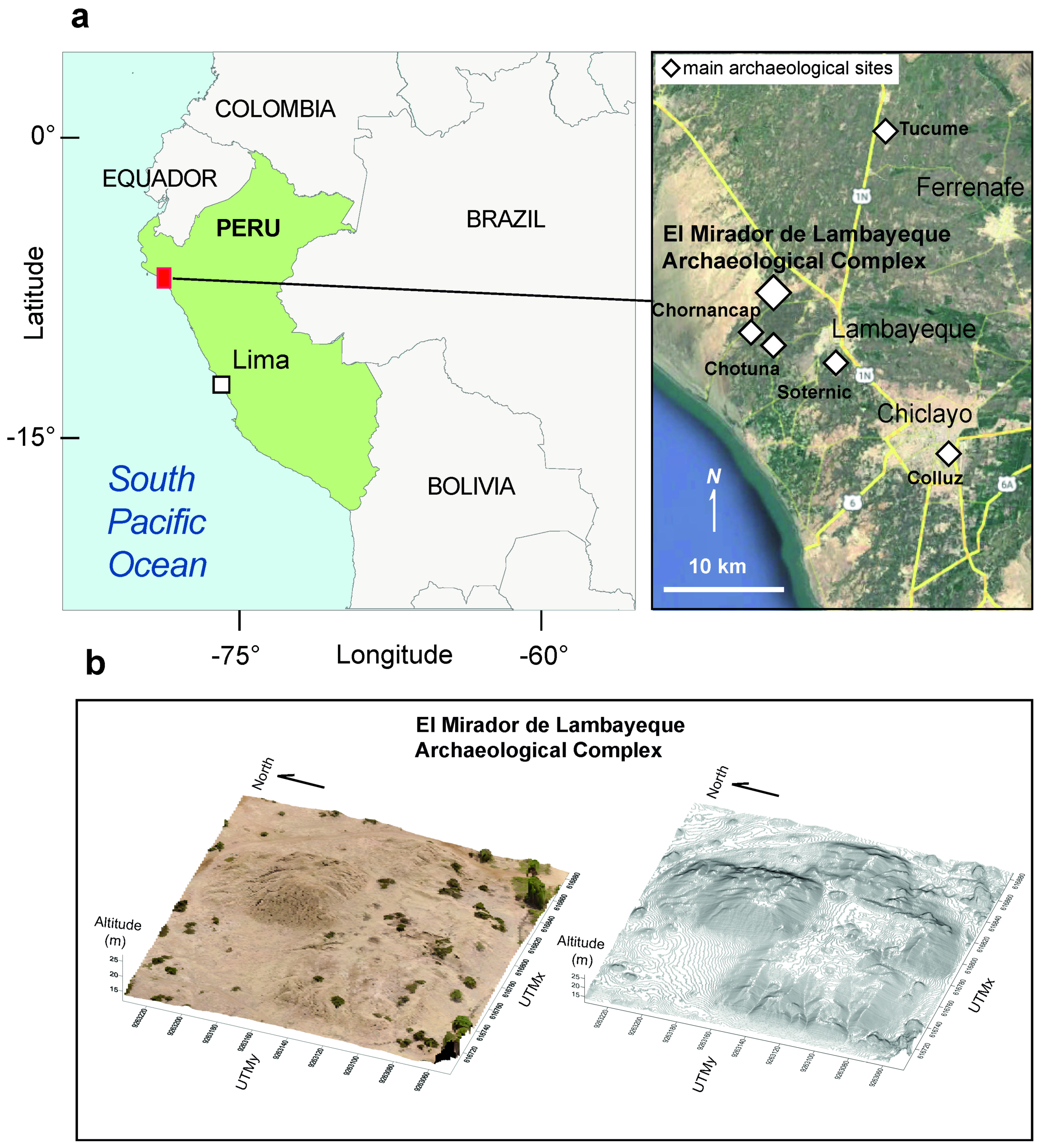
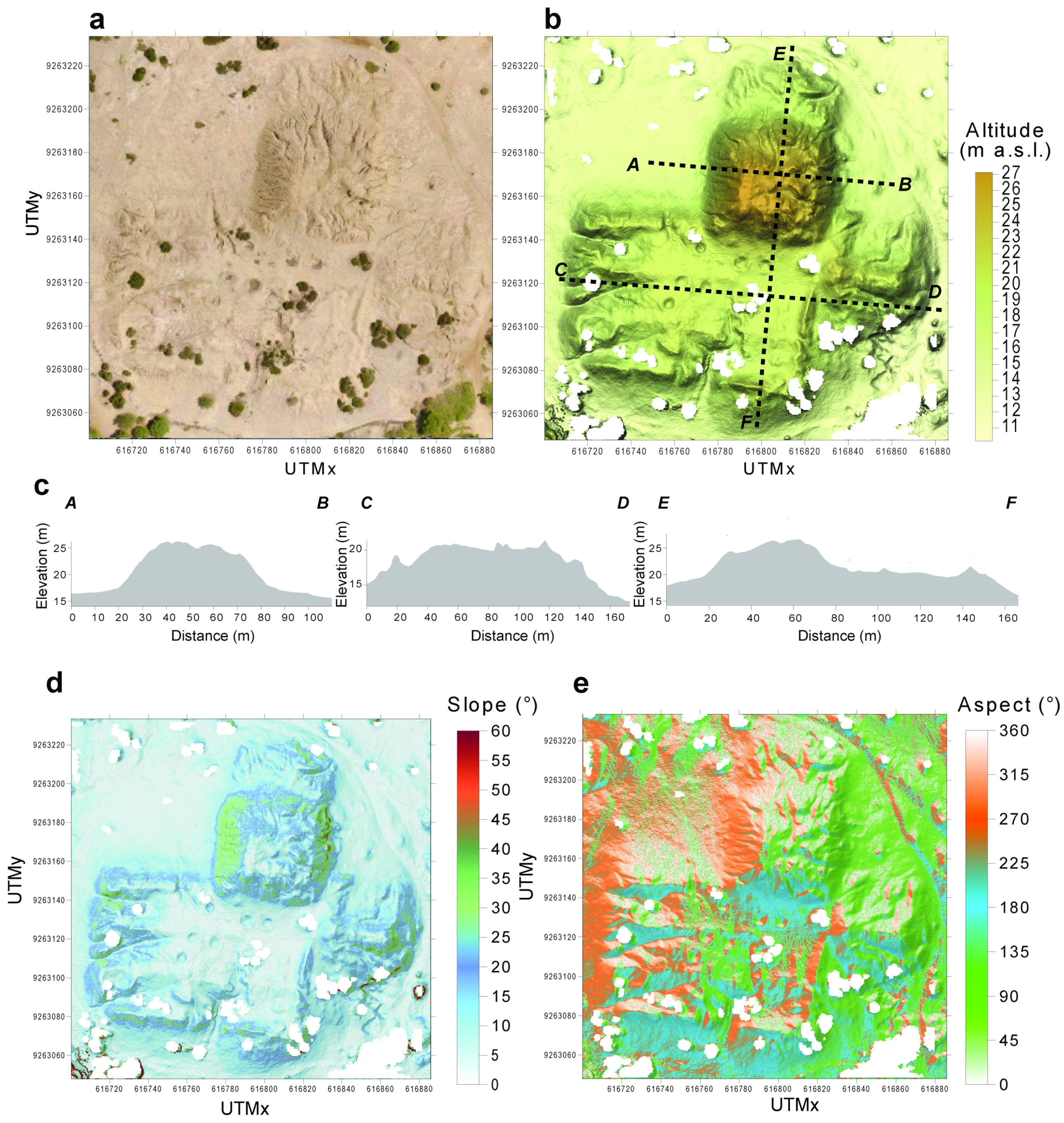

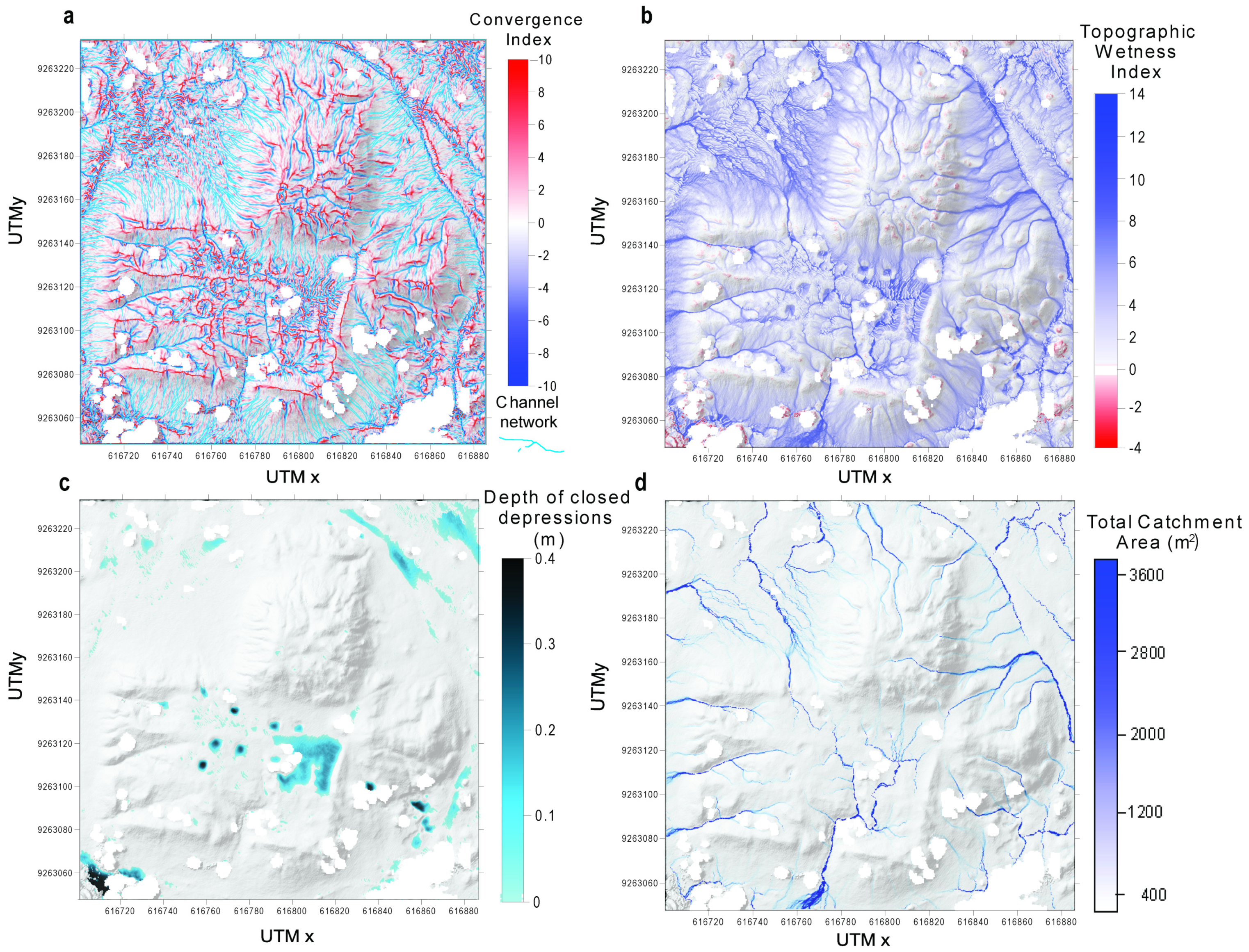
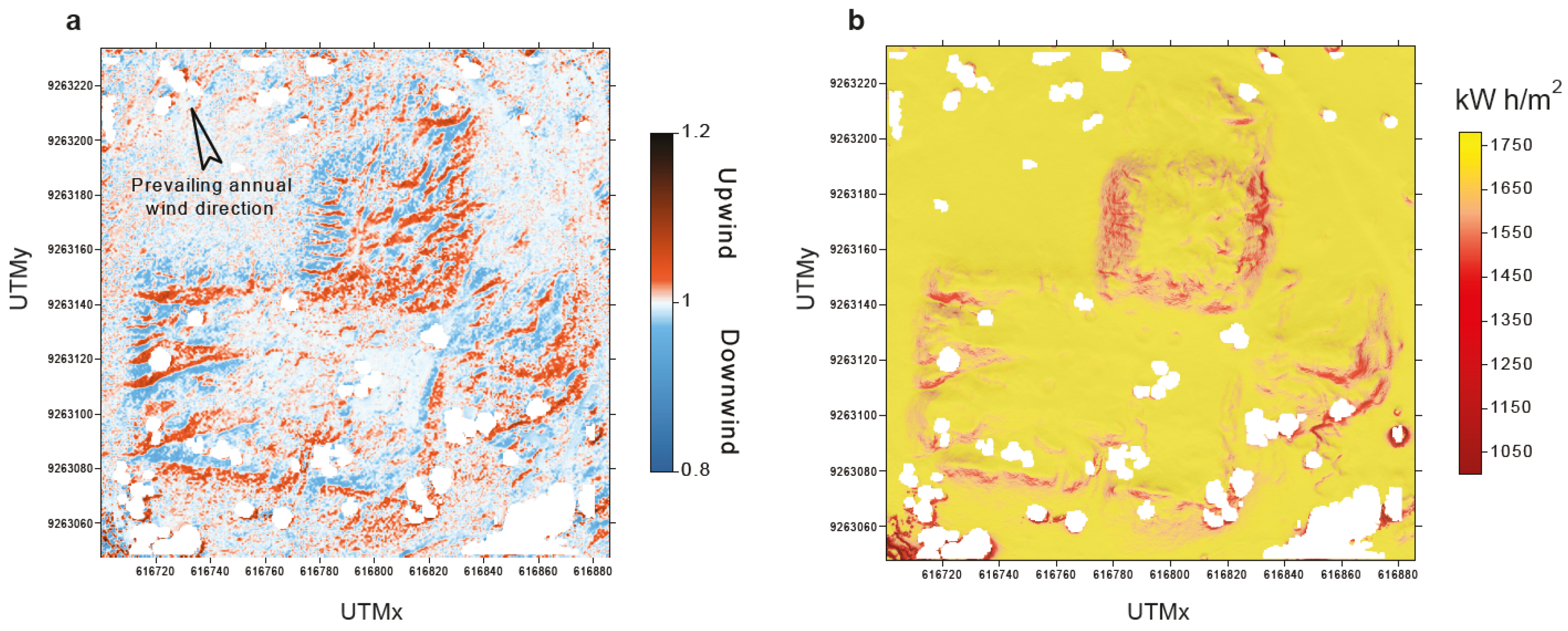
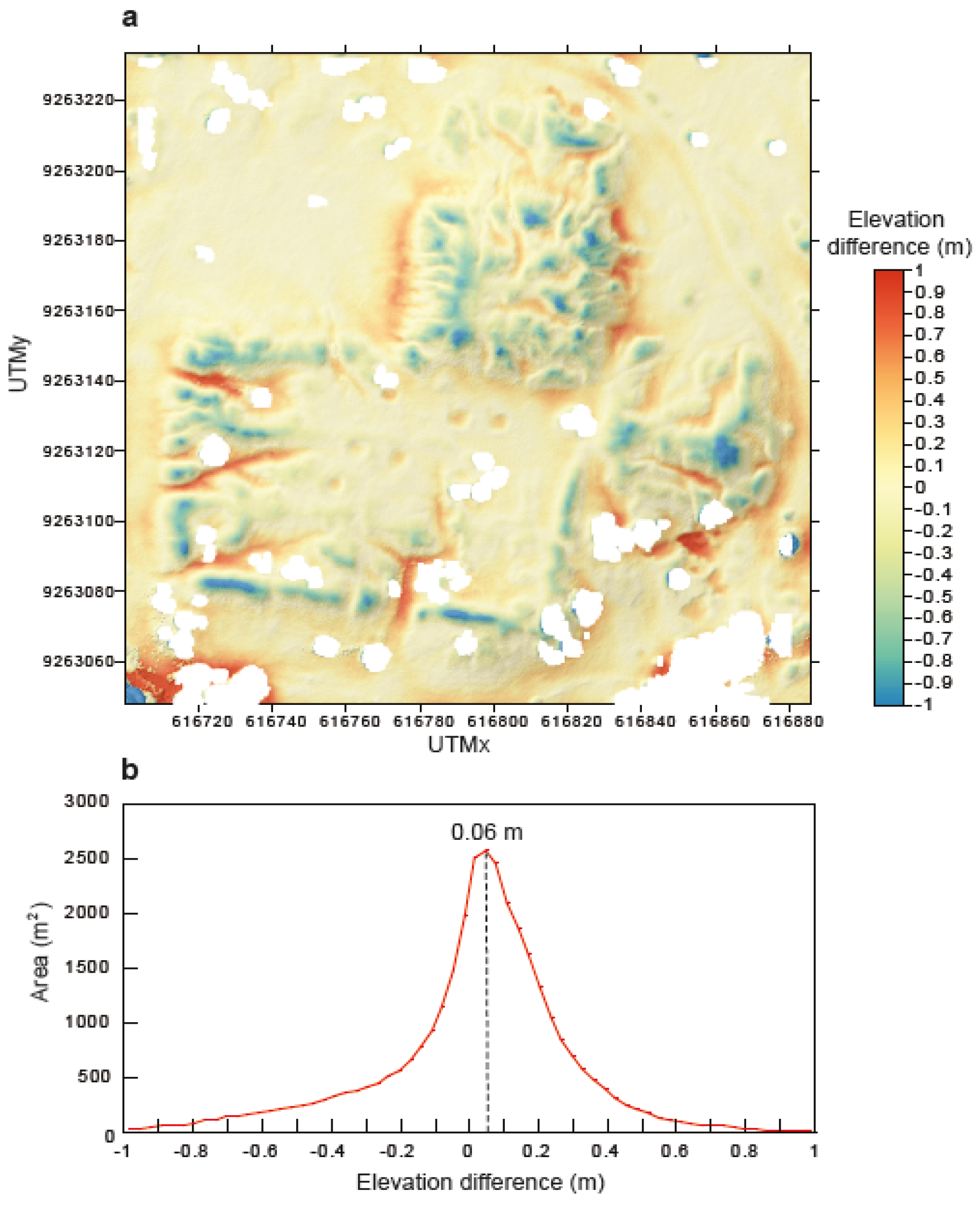
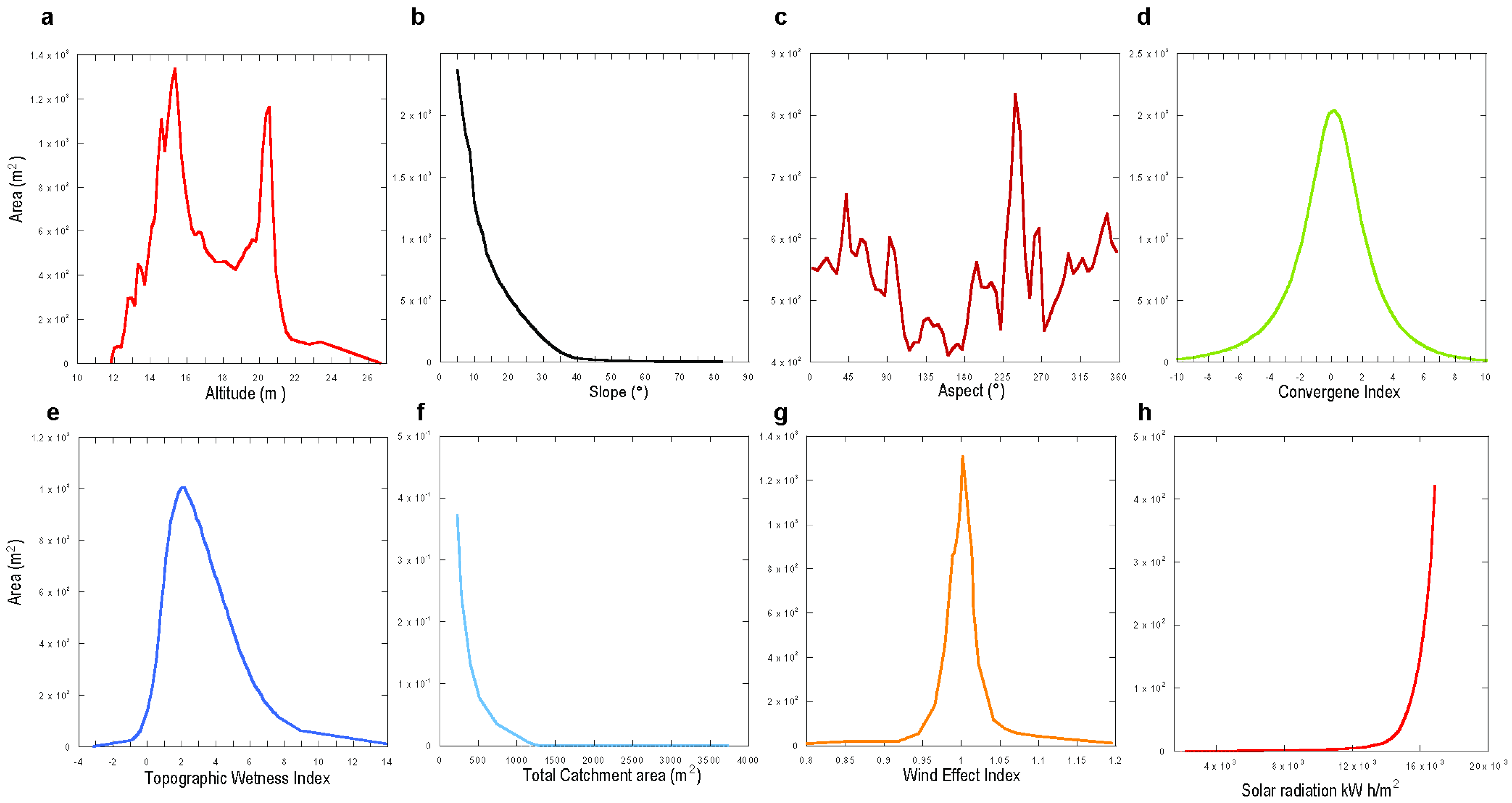

Disclaimer/Publisher’s Note: The statements, opinions and data contained in all publications are solely those of the individual author(s) and contributor(s) and not of MDPI and/or the editor(s). MDPI and/or the editor(s) disclaim responsibility for any injury to people or property resulting from any ideas, methods, instructions or products referred to in the content. |
© 2025 by the authors. Licensee MDPI, Basel, Switzerland. This article is an open access article distributed under the terms and conditions of the Creative Commons Attribution (CC BY) license (https://creativecommons.org/licenses/by/4.0/).
Share and Cite
Magnini, L.; Del Gaudio, P.; Apa, M.I.P.; Cachay, R.F.G.; La Torre, C.E.W.; Ventura, G. Climatic Vulnerability of El Mirador de Lambayeque Archaeological Complex (8th–11th Century AD): Morphometric Analyses of Digital Surface Models. Remote Sens. 2025, 17, 1544. https://doi.org/10.3390/rs17091544
Magnini L, Del Gaudio P, Apa MIP, Cachay RFG, La Torre CEW, Ventura G. Climatic Vulnerability of El Mirador de Lambayeque Archaeological Complex (8th–11th Century AD): Morphometric Analyses of Digital Surface Models. Remote Sensing. 2025; 17(9):1544. https://doi.org/10.3390/rs17091544
Chicago/Turabian StyleMagnini, Luigi, Pierdomenico Del Gaudio, Maria Ilaria Pannaccione Apa, Robert F. Gutierrez Cachay, Carlos E. Wester La Torre, and Guido Ventura. 2025. "Climatic Vulnerability of El Mirador de Lambayeque Archaeological Complex (8th–11th Century AD): Morphometric Analyses of Digital Surface Models" Remote Sensing 17, no. 9: 1544. https://doi.org/10.3390/rs17091544
APA StyleMagnini, L., Del Gaudio, P., Apa, M. I. P., Cachay, R. F. G., La Torre, C. E. W., & Ventura, G. (2025). Climatic Vulnerability of El Mirador de Lambayeque Archaeological Complex (8th–11th Century AD): Morphometric Analyses of Digital Surface Models. Remote Sensing, 17(9), 1544. https://doi.org/10.3390/rs17091544






